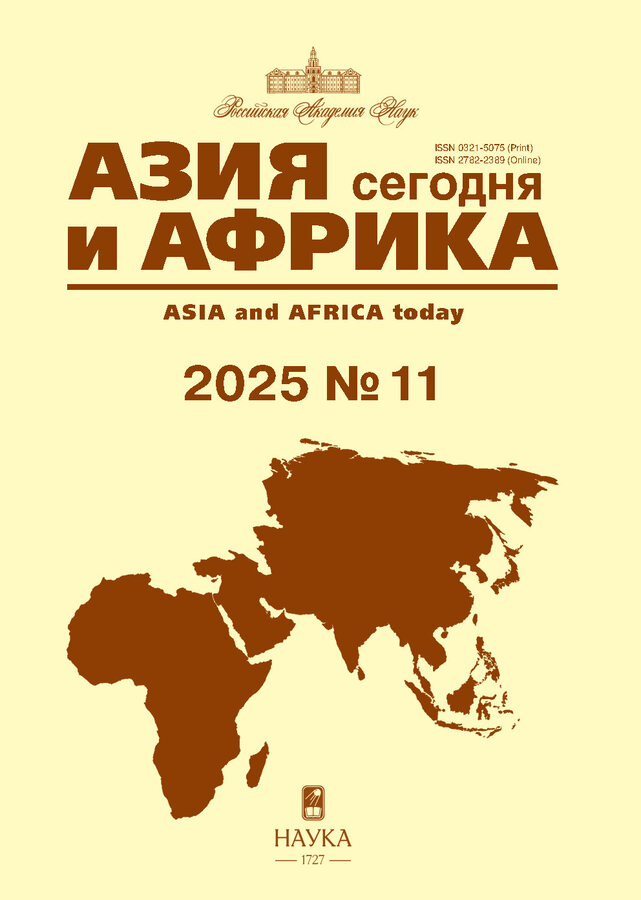Structural Limits of EU's "Strategic Autonomy" in the Indo-Pacific: Role of US and Chinese Policies
- Authors: Timakova O.A1
-
Affiliations:
- Diplomatic Academy, Ministry of Foreign Affairs of Russia
- Issue: No 11 (2025)
- Pages: 5-13
- Section: Politics, economics
- URL: https://cardiosomatics.orscience.ru/0321-5075/article/view/696462
- DOI: https://doi.org/10.31857/S0321507525110017
- ID: 696462
Cite item
Abstract
The article is devoted to the study of structural limitations that prevent the European Union from achieving its stated goal of "strategic autonomy". The aim of the work is to identify the key factors that undermine the independence of the EU policy in the context of the escalating global confrontation between the United States and China. Due to the close allied relations between the EU and the United States, Europe finds itself in the triangle of the United States – China – European Union. The United States seeks to oblige European allies to actively participate in the implementation of programs to contain China. The limited military and political potential of the EU, dependence on the United States in the security sphere, and internal disunity of the member states reduce the declared "strategic autonomy" to the need to balance between Washington and Beijing. The work systematizes the challenges to the EU's foreign policy sovereignty, which contributes to the understanding of the dynamics of modern international relations in the IPR and the transformation of Europe's role in a multipolar world.
Keywords
About the authors
O. A Timakova
Diplomatic Academy, Ministry of Foreign Affairs of Russia
Email: o.timakova@dipacademy.ru
ORCID iD: 0000-0003-4185-0194
PhD (Political Science), Associate Professor, Department of Political Science and Political Philosophy Moscow, Russia
References
- Biba S. (Ed.). 2024. Europe in an Era of US-China Strategic Rivalry, Global Power Shift. Cham: Springer.
- Grare F. 2021. Reuter M. Moving Closer: European Views of the Indo-Pacific. Berlin: European Council on Foreign Relations.
- Melnikova Yu.Yu. 2022. EU strategy in the Indo-Pacific region: domestic drivers and the Chinese factor. Humanities and Social Sciences. Bulletin of the Financial University. № 2. Pp. 31–37. (In Russ.)
- Leushkin D.V., Samoilov N.G. 2024. The EU strategic approach to China (2016–2023). Contemporary Europe. № 5. Pp. 49–59. (In Russ.)
- Korovnikova N.A. 2024. The EU-PRC: cooperation, competition or "de-risking"? Current Problems of Europe. № 4. Pp. 87–105. (In Russ.)
- Hang Y. 2022. The EU Indo-Pacific Strategy and the China-Russia relations. Vestnik of Saint Petersburg University. International Relations. № 3. Pp. 311–329.
- Jian J., Fang J. 2024. The EU's Indo-Pacific Strategy. Motivations, influences, challenges, and implications for China. Vestnik of Saint Petersburg University. International Relations. № 1. Pp. 5–26.
- Romanova T.A. 2024. The Evolution of the discourse on sovereignty and sanctions and its significance for the EU's external relations. International Trends. № 1. С. 22–41. (In Russ.)
- Pugliese G. 2023. The European Union's Security Intervention in the Indo-Pacific: Between Multilateralism and Mercantile Interests. Journal of Intervention and Statebuilding. № 1. Pp. 76–98.
- Van Willigen N., Blarel N. 2025. Why, how and to whom is the European Union signalling in the Indo-Pacific? Understanding the European Union's strategy in the Indo-Pacific in the epicentre of multipolar competition. The British Journal of Politics and International Relations. № 1. Pp. 69–90.
- Schneider-Petsinger M., Nouwens V., Billon-Galland A., Cainey A., Price G. 2022. Transatlantic cooperation on the Indo-Pacific European and US priorities, partners and platforms. L.: Chatham House.
- Lai S., Bacon P., Holland M. 2023. Three decades on: Still a capability-expectations gap? Pragmatic expectations towards the EU from Asia in 2020. JCMS: Journal of Common Market Studies. № 2. Pp. 451–468.
- Ellison D., van Hooft P. 2024. NATO should not go to the Indo-Pacific. Atlantisch Perspectief. № 2. Pp. 30–35.
- Van Hooft P., Girardi B., Sweijs T. 2022. Guarding the Maritime Commons: What Role for Europe? The Hague: The Hague Centre for Strategic Studies.
- Childs N. 2023. The AUKUS Anvil: Promise and Peril. Survival. № 5. Pp. 7–24.
- Fedorovskiy A.N. 2024. The Indo-Pacific Region Between the Challenges of Confrontation and Opportunities for Interaction. MEMO Journal. № 10. Pp. 5–16. (In Russ.)
- Ikenberry G.J. 2024. Three worlds: The West, East and South and the competition to shape global order. International Affairs. № 1. Pp. 121–138.
- Plagemann J. 2025. Introduction to special issue: 'Foreign policy signaling in the Indo-Pacific: Responses to the US-China rivalry in a multipolar world'. British Journal of Politics and International Relations. № 1. Pp. 3–19.
- Lee S., Schreer B. 2022. Will Europe defend Taiwan? The Washington Quarterly. № 3. Pp. 163–182.
Supplementary files











